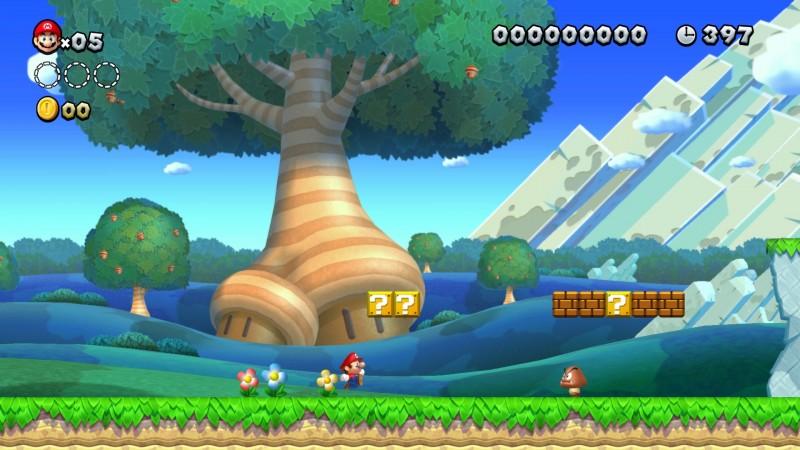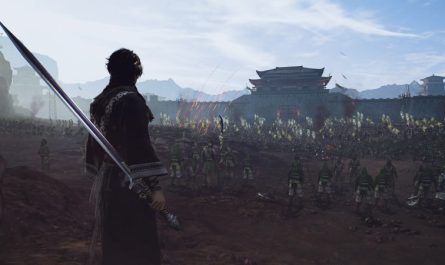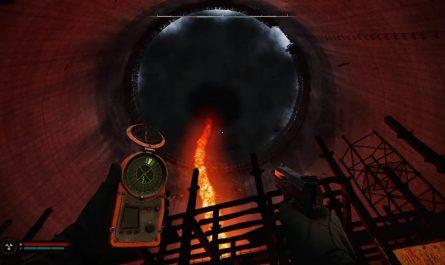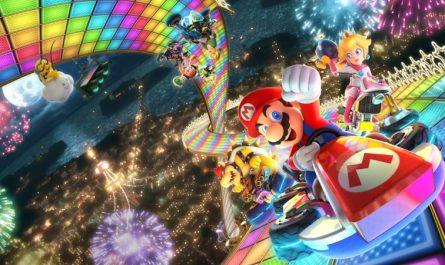In 2006, the iconic Super Mario series celebrated 10 years since its triumphant leap to 3D with Super Mario 64. That seminal entry proved that Nintendo’s iconic plumber could transition to 3D and still be the juggernaut franchise it was in 2D. It also became the blueprint for nearly every 3D platformer for the next several years. Super Mario 64 looked amazing in motion, but more importantly, it played like a dream. To say it revolutionized gaming would be an understatement.
In 2002, Nintendo released Super Mario Sunshine on GameCube to critical and fan acclaim. The visual improvements from the Nintendo 64 and the GameCube were apparent, and Super Mario Sunshine once again proved to be a hit with both fans and critics. While many celebrated the continued success of this 3D evolution for one of gaming’s most important and beloved franchises, some wondered if Mario’s 2D past was just that: the past.
New Super Mario Bros. (2006)
The last 2D Super Mario game was released in 1995 with Super Mario World 2: Yoshi’s Island on the Super Nintendo, and the Game Boy Advance received only remakes of previous Mario side-scrollers. As Nintendo worked on the next 3D entry, the now-adored Super Mario Galaxy for its supremely popular Wii console, the company looked towards its even more popular handheld system, the Nintendo DS, as a potential home for a return to 2D Mario.
The result was New Super Mario Bros., a game that brought the series back to the classic 2D gameplay but with modern visuals and gameplay conventions. “We’d been working on the New Super Mario Bros. series based on the idea of recreating the experience of the original Super Mario Bros., which released in 1985, in a new way,” producer of Super Mario Bros. Wonder and the New Super Mario Bros. series Takashi Tezuka says. “You can think of it as carefully preserving the core gameplay while dressing it up with new elements that enhance it.”
By recapturing the magic of the classic entries and bringing it forward into the then-modern era, 2006’s New Super Mario Bros. was a critical darling and a massive success with players. The game sold nearly 31 million copies, becoming the highest-selling game on Nintendo’s best-selling system of all time.
“For the New Super Mario Bros. series, we did what we always do, which is go back and review what we had in the past, and we looked at how we could make changes to make something appropriate for the current generation,” Tezuka says. “The New Super Mario Bros. series continued for a long period of time, and one of the things I think we accomplished during that period was creating new Mario fans.”
New Super Mario Bros. Wii (2009)
The success of the DS entry led to three sequels across three different platforms: New Super Mario Bros. Wii in 2009, New Super Mario Bros. 2 on 3DS in 2012, and New Super Mario Bros. U on Wii U, also in 2012. Each entry in the franchise sold extremely well, charting at least in the top five of their respective console’s all-time sales chart. Even the Switch port of New Super Mario Bros. U currently sits in the top 10 for overall sales on the Nintendo Switch.
It’s safe to say that Nintendo’s attempt at bringing Mario back to 2D after the hiatus in the late ’90s and early 00’s was a success. However, following 2012’s New Super Mario Bros. U, the series went dark. Though the New Super Mario Bros. games always sold well, more critical voices emerged with each subsequent entry, claiming series stagnation. Each entry was well-made and well-designed, but the games began feeling too similar to one another. Nintendo released the aforementioned Switch port in 2019, and that same year, Super Mario Maker 2 featured it as a style with which players could create courses, but the popular subseries of Mario all but vanished.
New Super Mario Bros. U (2012)
Much like in the advent of the last 2D revival for the franchise, a similar gap formed in the time since the last New Super Mario Bros. game. In fact, the elongated gap between Super Mario World 2: Yoshi’s Island on SNES and New Super Mario Bros. on DS matches the 11 years since the last all-new home console 2D Super Mario Bros. game. And similarly, the franchise seemed focused on 3D entries in the meantime, with titles like Super Mario 3D World and Super Mario Odyssey carrying the franchise flag.
Though the absence had become elongated, Nintendo was far from resting on its laurels, as the developers continued to think about ways to deliver in a way that both they and their fans would be happy. “There’s been quite a bit of time since the last installment in the New Super Mario Bros. franchise, but when we’re creating another iteration in the series, we understand that we have to go above and beyond the last title,” Tezuka says. “And so, for us, we were really filled with a lot of very strong feelings about wanting to create something with a lot of very rich content.”
During this absence, fans of the 2D side could get their fix through Super Mario Run, an auto-runner for mobile devices, or make their own fun with the two entries in the Super Mario Maker franchise. But it wasn’t the same. However, Nintendo seems to have found a way to one-up the games of its past and now, the 2D side of the series is poised for yet another injection of life and groundbreaking comeback with Super Mario Bros. Wonder.
Super Mario Bros. Wonder (2023)
“The New Super Mario Bros. series has been going on for a while since the release of New Super Mario Bros. on Nintendo DS, so we wanted to create an all-new 2D Mario experience,” Super Mario Bros. Wonder director Shiro Mouri, who also worked on New Super Mario Bros. 2 and New Super Mario Bros. U, says. “That’s how [Super Mario Bros. Wonder] started. We also created the system for the game from scratch.”
This new entry signals the end of an era for Nintendo, which had delivered those four New Super Mario Bros. titles prior to this past summer’s announcement of Super Mario Bros. Wonder. But the company is hesitant to say that Super Mario Bros. Wonder will serve as the blueprint for future games in the same way that New Super Mario Bros. did back in 2006.
“I believe that we have transitioned from the New Super Mario Bros. series into a new phase, but at this point, we have no idea what the next game style will be,” Tezuka says.
“However, what we do know is that Super Mario Bros. Wonder has set a bigger stage for adventure for Mario and friends,” art director Masanobu Sato says in response.
Super Mario Bros. Wonder, the series’ first all-new 2D console platformer in 11 years, arrives on Switch on October 20. For more on this exciting new entry and how it’s changing things up from the New Super Mario Bros. series, visit our hub by clicking the banner below.
In 2006, the iconic Super Mario series celebrated 10 years since its triumphant leap to 3D with Super Mario 64. That seminal entry proved that Nintendo’s iconic plumber could transition to 3D and still be the juggernaut franchise it was in 2D. It also became the blueprint for nearly every 3D platformer for the next several years. Super Mario 64 looked amazing in motion, but more importantly, it played like a dream. To say it revolutionized gaming would be an understatement.
In 2002, Nintendo released Super Mario Sunshine on GameCube to critical and fan acclaim. The visual improvements from the Nintendo 64 and the GameCube were apparent, and Super Mario Sunshine once again proved to be a hit with both fans and critics. While many celebrated the continued success of this 3D evolution for one of gaming’s most important and beloved franchises, some wondered if Mario’s 2D past was just that: the past.
New Super Mario Bros. (2006)
The last 2D Super Mario game was released in 1995 with Super Mario World 2: Yoshi’s Island on the Super Nintendo, and the Game Boy Advance received only remakes of previous Mario side-scrollers. As Nintendo worked on the next 3D entry, the now-adored Super Mario Galaxy for its supremely popular Wii console, the company looked towards its even more popular handheld system, the Nintendo DS, as a potential home for a return to 2D Mario.
The result was New Super Mario Bros., a game that brought the series back to the classic 2D gameplay but with modern visuals and gameplay conventions. “We’d been working on the New Super Mario Bros. series based on the idea of recreating the experience of the original Super Mario Bros., which released in 1985, in a new way,” producer of Super Mario Bros. Wonder and the New Super Mario Bros. series Takashi Tezuka says. “You can think of it as carefully preserving the core gameplay while dressing it up with new elements that enhance it.”
By recapturing the magic of the classic entries and bringing it forward into the then-modern era, 2006’s New Super Mario Bros. was a critical darling and a massive success with players. The game sold nearly 31 million copies, becoming the highest-selling game on Nintendo’s best-selling system of all time.
“For the New Super Mario Bros. series, we did what we always do, which is go back and review what we had in the past, and we looked at how we could make changes to make something appropriate for the current generation,” Tezuka says. “The New Super Mario Bros. series continued for a long period of time, and one of the things I think we accomplished during that period was creating new Mario fans.”
New Super Mario Bros. Wii (2009)
The success of the DS entry led to three sequels across three different platforms: New Super Mario Bros. Wii in 2009, New Super Mario Bros. 2 on 3DS in 2012, and New Super Mario Bros. U on Wii U, also in 2012. Each entry in the franchise sold extremely well, charting at least in the top five of their respective console’s all-time sales chart. Even the Switch port of New Super Mario Bros. U currently sits in the top 10 for overall sales on the Nintendo Switch.
It’s safe to say that Nintendo’s attempt at bringing Mario back to 2D after the hiatus in the late ’90s and early 00’s was a success. However, following 2012’s New Super Mario Bros. U, the series went dark. Though the New Super Mario Bros. games always sold well, more critical voices emerged with each subsequent entry, claiming series stagnation. Each entry was well-made and well-designed, but the games began feeling too similar to one another. Nintendo released the aforementioned Switch port in 2019, and that same year, Super Mario Maker 2 featured it as a style with which players could create courses, but the popular subseries of Mario all but vanished.
New Super Mario Bros. U (2012)
Much like in the advent of the last 2D revival for the franchise, a similar gap formed in the time since the last New Super Mario Bros. game. In fact, the elongated gap between Super Mario World 2: Yoshi’s Island on SNES and New Super Mario Bros. on DS matches the 11 years since the last all-new home console 2D Super Mario Bros. game. And similarly, the franchise seemed focused on 3D entries in the meantime, with titles like Super Mario 3D World and Super Mario Odyssey carrying the franchise flag.
Though the absence had become elongated, Nintendo was far from resting on its laurels, as the developers continued to think about ways to deliver in a way that both they and their fans would be happy. “There’s been quite a bit of time since the last installment in the New Super Mario Bros. franchise, but when we’re creating another iteration in the series, we understand that we have to go above and beyond the last title,” Tezuka says. “And so, for us, we were really filled with a lot of very strong feelings about wanting to create something with a lot of very rich content.”
During this absence, fans of the 2D side could get their fix through Super Mario Run, an auto-runner for mobile devices, or make their own fun with the two entries in the Super Mario Maker franchise. But it wasn’t the same. However, Nintendo seems to have found a way to one-up the games of its past and now, the 2D side of the series is poised for yet another injection of life and groundbreaking comeback with Super Mario Bros. Wonder.
Super Mario Bros. Wonder (2023)
“The New Super Mario Bros. series has been going on for a while since the release of New Super Mario Bros. on Nintendo DS, so we wanted to create an all-new 2D Mario experience,” Super Mario Bros. Wonder director Shiro Mouri, who also worked on New Super Mario Bros. 2 and New Super Mario Bros. U, says. “That’s how [Super Mario Bros. Wonder] started. We also created the system for the game from scratch.”
This new entry signals the end of an era for Nintendo, which had delivered those four New Super Mario Bros. titles prior to this past summer’s announcement of Super Mario Bros. Wonder. But the company is hesitant to say that Super Mario Bros. Wonder will serve as the blueprint for future games in the same way that New Super Mario Bros. did back in 2006.
“I believe that we have transitioned from the New Super Mario Bros. series into a new phase, but at this point, we have no idea what the next game style will be,” Tezuka says.
“However, what we do know is that Super Mario Bros. Wonder has set a bigger stage for adventure for Mario and friends,” art director Masanobu Sato says in response.
Super Mario Bros. Wonder, the series’ first all-new 2D console platformer in 11 years, arrives on Switch on October 20. For more on this exciting new entry and how it’s changing things up from the New Super Mario Bros. series, visit our hub by clicking the banner below.Read MoreGame Informer



